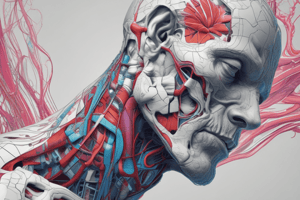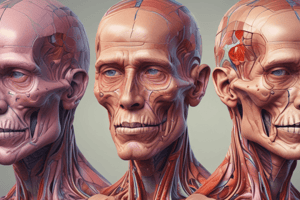Podcast
Questions and Answers
What anatomical feature connects the upper skull with the lower jaw?
What anatomical feature connects the upper skull with the lower jaw?
- Zygomatic Arch
- Temporomandibular Joint (correct)
- Masseter Muscle
- Buccal Region
Which region of the face is primarily composed of the soft tissue of the cheek?
Which region of the face is primarily composed of the soft tissue of the cheek?
- Buccal Region (correct)
- Zygomatic Region
- Temporal Region
- Nasal Region
What is a prominent muscle that can be palpated when a patient clenches their teeth?
What is a prominent muscle that can be palpated when a patient clenches their teeth?
- Temporalis Muscle
- Digastric Muscle
- Sternocleidomastoid Muscle
- Masseter Muscle (correct)
How can the face be divided for functional and esthetic purposes?
How can the face be divided for functional and esthetic purposes?
What guideline is applied for comparing the three parts of the face?
What guideline is applied for comparing the three parts of the face?
What condition can lead to a loss of height in the lower third of the face?
What condition can lead to a loss of height in the lower third of the face?
Which of the following statements about the vertical dimension of the face is correct?
Which of the following statements about the vertical dimension of the face is correct?
Which division of the vertical dimension of the face is at risk with periodontal disease?
Which division of the vertical dimension of the face is at risk with periodontal disease?
What is the primary function of the middle ear?
What is the primary function of the middle ear?
Which part of the internal ear is specifically dedicated to hearing?
Which part of the internal ear is specifically dedicated to hearing?
What is contained within the orbital region?
What is contained within the orbital region?
What is the function of the iris in the eye?
What is the function of the iris in the eye?
Which structure appears black in the center of the iris?
Which structure appears black in the center of the iris?
Which part of the internal ear is responsible for balance?
Which part of the internal ear is responsible for balance?
What lines the middle ear?
What lines the middle ear?
What type of space is the middle ear?
What type of space is the middle ear?
What forms the fauces laterally on each side?
What forms the fauces laterally on each side?
Which structure is located between the anterior and posterior faucial pillars?
Which structure is located between the anterior and posterior faucial pillars?
What is another name for the anterior and posterior faucial pillars?
What is another name for the anterior and posterior faucial pillars?
What is the major feature of the mental region?
What is the major feature of the mental region?
What is the prominence of the chin called?
What is the prominence of the chin called?
What separates the lower lip from the chin?
What separates the lower lip from the chin?
Which feature is NOT a part of the oropharynx?
Which feature is NOT a part of the oropharynx?
Which structure is primarily referred to as 'tonsils' by patients?
Which structure is primarily referred to as 'tonsils' by patients?
What is the term for the prominence of the forehead?
What is the term for the prominence of the forehead?
Which area is located directly inferior to each eyebrow?
Which area is located directly inferior to each eyebrow?
What is the primary focus of surface anatomy as described?
What is the primary focus of surface anatomy as described?
What is the smooth elevated area between the eyebrows called?
What is the smooth elevated area between the eyebrows called?
Which region is covered by the scalp?
Which region is covered by the scalp?
Which of the following is NOT a region of the head?
Which of the following is NOT a region of the head?
Why must dental professionals be familiar with surface anatomy?
Why must dental professionals be familiar with surface anatomy?
Which of the following describes the Temporal Region?
Which of the following describes the Temporal Region?
What does the term 'posterior' refer to in relation to the Temporal Region?
What does the term 'posterior' refer to in relation to the Temporal Region?
Which region of the head is associated with the side of the head?
Which region of the head is associated with the side of the head?
What are landmarks of surface anatomy primarily used for?
What are landmarks of surface anatomy primarily used for?
What prominent feature is included in the Auricular Region?
What prominent feature is included in the Auricular Region?
Which structure is NOT found in the Frontal Region?
Which structure is NOT found in the Frontal Region?
Which of the following pairs is correctly matched?
Which of the following pairs is correctly matched?
Surface anatomy can help in assessing which part of the body?
Surface anatomy can help in assessing which part of the body?
The zygomatic region is better known as the:
The zygomatic region is better known as the:
Flashcards are hidden until you start studying
Study Notes
Head Anatomy
- The head can be divided into 12 regions: frontal, parietal, occipital, temporal, auricular, orbital, nasal, infraorbital, zygomatic, buccal, oral, and mental.
- The frontal region includes the forehead and the area superior to the eyes.
- Supraorbital ridge: Directly inferior to each eyebrow, aka, superciliary ridge.
- Glabella: The smooth elevated area between the eyebrows
- Frontal Eminence: The prominence of the forehead
- The parietal and occipital regions are covered by the scalp.
- The temporal region contains the temple, the superficial side of the head posterior to each eye.
- The auricular region is located on each side of the head and includes the external ear.
- The orbital region is on each side of the head and contains the bony socket of the eye.
- Includes the sclera, the white area of the eye.
- Iris: The colored area of the eye.
- Pupil: The opening in the center of the iris, appearing black.
- The nasal region includes the nose, the bony projection in the middle of the face.
- The infraorbital region is the area directly below the orbit, contains the infraorbital foramen where blood vessels and a nerve pass through.
- The zygomatic region is the cheekbone. It is a bone that helps to form the cheek and the lateral wall of the orbit.
- Temporomandibular joint: It is where the upper skull forms a joint with the lower jaw.
- The buccal region is the soft tissue of the cheek.
- Masseter muscle: Can be felt when the patient clenches their teeth; found in the buccal region of the head.
- The oral region is the mouth.
- The mental region is the chin region.
- The mental protuberance is the prominence of the chin.
- The labiomental groove is located between the lower lip and the chin.
- The vertical dimension of the face can be divided into three sections.
- The loss of height in the lower third can occur due to aging and periodontal disease.
Anatomy of the Ear
- The middle ear is an air-filled space within the temporal bone, lined with mucous membranes.
- It transmits vibrations from the tympanic membrane to the inner ear.
- The inner ear is responsible for sound detection and balance.
- It consists of the cochlea, which is dedicated to hearing.
- It also consists of the vestibular system, which is dedicated to balance.
Neck Anatomy
- The neck is a complex area, and it is important to be familiar with the major structures that make up this area.
- The neck regions include:
- Hyoid region: (above the thyroid cartilage)
- Thyroid region: (the thyroid cartilage)
- Laryngeal region: (the trachea)
- Cervical region:(bones between the head and neck)
- Submandibular region: (under the jaw)
Studying That Suits You
Use AI to generate personalized quizzes and flashcards to suit your learning preferences.




